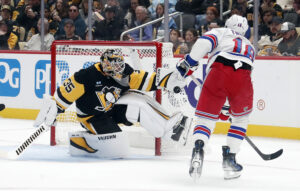Welcome back to Top Shelf Prospects. The major junior hockey season is several weeks old and we’re here to take a look around the Western Hockey League. Today, we bring you our 2019-20 WHL East Division Players to Watch.
You can check out all of this year’s Top Shelf Prospects articles here.
2019-20 WHL East Division
Players to Watch
Luka Burzan, Centre, Brandon Wheat Kings
The 6th overall pick in the 2015 WHL Draft, Burzan was overlooked twice in the NHL Draft before being taken by the Colorado Avalanche last year. Burzan has good size and marries it with strong skating and a good work ethic to play a strong two-way game. He has a strong wrist shot and a quick release. Burzan has also shown good vision and passing skills. A hard worker, Burzan gets in quickly on the forecheck, creating turnovers. He also goes to the net without the puck. Burzan has also shown a strong defensive game. He should put up a big year, playing as an overager in Brandon.
Brayden Tracey, Left Wing, Moose Jaw Warriors
Tracey is a very smart offensive player. He has a knack for finding openings in the defence and getting into those spots. This sets him up to take a pass from a teammate and convert with a quick wrist shot or one-timer. Tracey’s shot is strong and accurate and he has a quick release. A natural goal scorer, he can also convert in tight to the net with good hand-eye coordination and the ability to pounce on rebounds. He doesn’t always show the willingness to battle in those key areas though, Tracey prefers to dart in and out of those positions. If the defenders play him physically, he can have a tendency to play a bit of a perimeter game. Tracey uses his smarts to be a playmaker as well. He anticipates where his linemates are going and he has the patience to wait for them to get open.
Cole Fonstad, Left Wing/Centre, Prince Albert Raiders
A Montreal Canadiens prospect, Fonstad is an excellent playmaker. He slows plays down and has the patience to wait for plays to develop. Fonstad has excellent vision. He is a very smart player, anticipating where his teammates will be and hitting them with a tape-to-tape pass. Fonstad can put the puck through tight areas. He controls the play on the half-boards on the power play and creates plays from there. Fonstad has a good release on his wrist shot, and it is accurate. However, it lacks some power and he can have trouble scoring from outside the slot. He also does not seem to get that involved in the corners or in front of the net. When he does, Fonstad can be overpowered. He could use a bit more muscle on his frame.
Austin Pratt, Right Wing, Regina Pats
After scoring 25 goals and 51 points last season Pratt returns for an overage season. Coming in at 6-foot-3 and 215 pounds, Pratt plays a power game. He creates offence by getting in quickly on the forecheck and creating turnovers and offensive chances for his line. With and without the puck Pratt loves to go to the front of the net, where he creates havoc for opposing goaltenders and defenders. His wrist shot is powerful but he could use some work on his release. Instead, most of his goals come in close to the net as he bangs in rebounds and short passes from teammates as well as deflecting pucks past the goalie.
Kirby Dach, Centre, Saskatoon Blades
Dach is currently up with the Chicago Blackhawks while he recovers from a concussion. It is unclear if he will stay in the NHL or be sent back to Saskatoon once he is healthy. Of course, there is also the opportunity to play nine NHL games without burning a year on his ELC.
At 6-foot-4 Dach has the size to be a powerful centre. Dach takes the puck to the net and is more likely to go through a defender than to try and make a deke to get around him. He is very tough to contain on the cycle, as he protects the puck well and this allows him to extend plays down low and wait for a teammate to get open or for an opposing defender to get out of position. Dach has very good vision and passing skills. He finds open teammates and sets them up for scoring chances in tight. Dach also has a decent wrist shot and release.
Scott Walford, Defence, Saskatoon Blades
A third-round pick of the Montreal Canadiens in 2017, Walford was not signed despite a 47-point season last year. He was traded to Saskatoon in the off-season and will play an overage season with the Blades. Walford creates offence from the back end, with excellent passing ability. He uses his skating to create space in transition and makes a strong first pass to his teammates when that space opens up. He also has the ability to make plays at the blue line, quarterbacking the power play and setting up teammates. Walford could improve his slap shot from the point. He is a solid two-way player, who maintains good gap control and has strong positioning to cut down passing and shooting lanes. Walford is also not afraid to battle in his own end of the rink, both in front of the net and in the corners.
Peyton Krebs, Centre, Winnipeg Ice
Krebs injured his Achilles prior to the draft but was still taken by the Vegas Golden Knights. He will miss the start of the year but should be back for the stretch run.
Krebs is best known for his playmaking ability. He can thread the puck through extremely tight spaces, as well as make strong saucer passes. He is also good at passing the puck on his backhand. His strong hockey sense allows him to read the play and anticipate the movements of teammates and opponents. Krebs has excellent vision and finds the open man. His stickhandling is very good and he can make moves at top speed. When you couple this with his skating, he can create passing lanes with quick movements.
If defenders back off to respect his speed, Krebs can take advantage of the added room by letting go of a powerful and accurate wrist shot, with a quick release. He has the smarts to use the defenceman as a screen in these situations. Krebs could stand to add more power to his slap shot and one-timer.
Michal Teply, Right Wing/Left Wing, Winnipeg Ice
Teply is more of a playmaker than a goal scorer. He has outstanding vision and hockey IQ. Teply sees the play well and is able to anticipate where his linemates and opponents are headed. He uses his long stick to protect the puck and extend plays until they can get open. Once they do, Teply can make a quick pass through a seam. He finds the open man on the cycle and makes a smart pass. By moving the puck quickly, Teply is able to generate offence. He played the point on the power play this past season, controlling the game and setting up teammates in the offensive zone.
2020 NHL Draft Players to Watch
Ridly Greig, Centre/Left Wing, Brandon Wheat Kings
The son of former NHLer, and 1990 first-round pick Mark Greig, Ridly was taken 8th overall in the 2017 WHL Bantam Draft. He scored 35 points last year. Greig also played for Team Canada at the Hlinka-Gretzky Cup, putting up two goals and three points in five games and winning a silver medal. At 5-foot-11 and just 159 pounds, Greig will need to fill out his frame to be effective at the next level.
Greig makes up for his lack of size with excellent skating ability. He combines this with excellent stickhandling and can make plays at top speed, which makes him extremely dangerous off the rush. Greig has excellent vision and playmaking skills with the ability to quickly move the puck through tight areas and set up his teammates. He also has a very good shot and quick release.
Braden Schneider, Defence, Brandon Wheat Kings
Schneider played eight games for Team Canada at the Under-18 World Championships last spring. The late-2001 birthdate defender had 24 points in 58 games last season. He is a strong skater who handles the puck well. He can skate it out of danger and make plays in the neutral zone. Schneider is also a good passer who starts the transition game or can play the point in the offensive zone. However, he needs some work on his slap shot. Schneider has good positioning and gap control. He defends well against both the rush and the cycle game.
Daemon Hunt, Defence, Moose Jaw Warriors
Drafted 15th overall in the 2017 WHL Bantam Draft, Hunt scored seven goals and 20 points as a WHL rookie. He also made it onto Team Canada as an underager at last year’s U20 World Championships as well as playing in this summer’s Hlinka-Gretzky Cup. Hunt is a good skater, with strong edgework and agility and this helps him to play a two-way game. He has very good hockey IQ, reading the play and putting himself in the right position to cut down passing lanes and force shooters to bad positions on the outside. Hunt also is a good passer who can create offence in transition or by quarterbacking the play at the blue line.
Kaiden Guhle, Defence, Prince Albert Raiders
The younger brother of Anaheim Ducks prospect, Brendan Guhle was the first overall pick in the 2017 WHL Draft. Like his brother, he is a strong puck-moving defenceman. Guhle put up 17 points in 65 games as a WHL rookie but already has seven points in eight games this season. He also played for Team Canada at the Hlinka-Gretzky Cup. Guhle is an excellent skater, with very good speed and acceleration in both directions. He can lead the rush through the neutral zone. Guhle also has a good wrist shot and slap shot from the point. He is a two-way player with strong defensive instincts and ability as well.
WHL East Division Main Photo
KELOWNA, BC – JANUARY 16: Brayden Tracey #7 of the Moose Jaw Warriors skates against the Kelowna Rockets at Prospera Place on January 16, 2019 in Kelowna, Canada. (Photo by Marissa Baecker/Getty Images)






